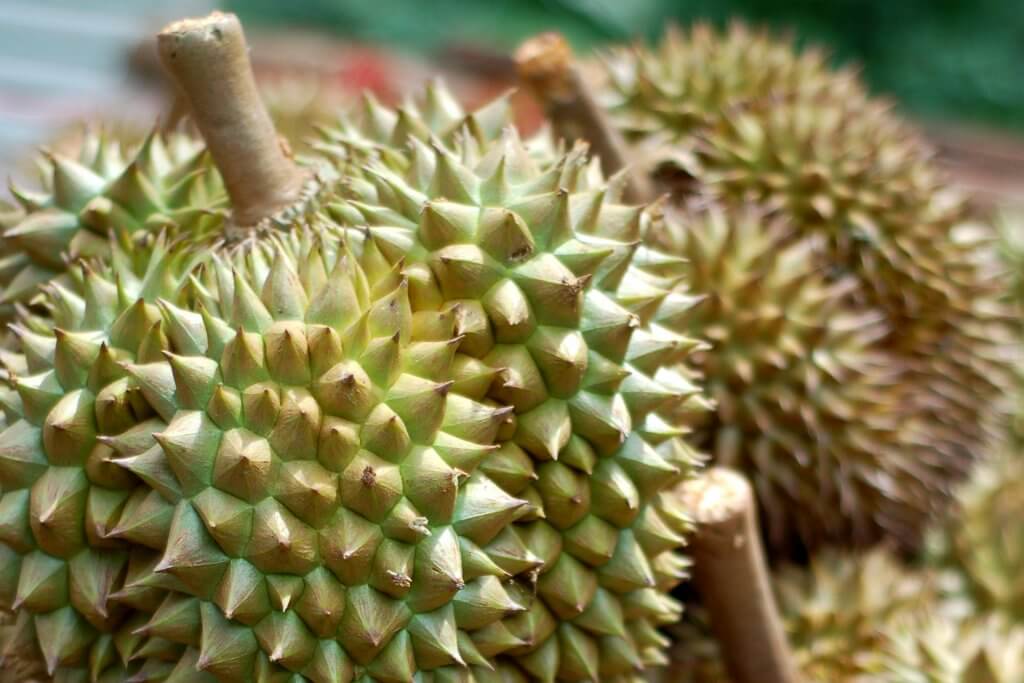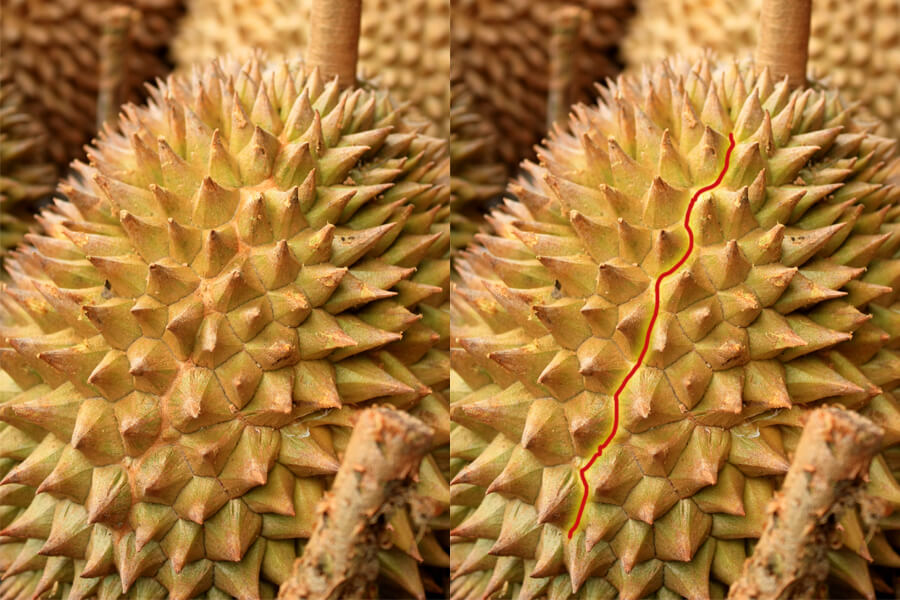
So you’ve picked a perfect durian, brought it home, taken it out of its week-old local newspaper gift wrap, and are ready to open it, only to realize you forgot to buy a pair of cut-resistant gloves, and are in for a bad time.
If you open durian like most people do, you’re right. It’s time to go back outside and get yourself some protective gear, lest you end up with chopped up hands (in the best case).
But, if you know how to find & utilize the “durian fault lines”, you’ll never again need to ruin your hands while endlessly hacking away at a durian in the hopes of opening it “any time now”.

Pronounced Doo-ri-an (like DOOm and ManchuRIAN – not like “foot”), it is famous for its delicious taste, highly subjective hate-it-or-love-it smell, and distinct protective husk, which is often capable of drawing blood, whether you’re handling it while you’re picking it, or getting ready to open it.
In the latter case, it is also notorious for being a difficult fruit to open – at least when you apply conventional (read: Western) methodologies to it.
Many times, if you’re buying a whole durian from a fruit vendor, they will either offer to open it for you, or be willing to do so if asked. In other cases, whether you don’t intend to eat it all that day, or you’re buying it from a supermarket with no such service, you’re going to have to open it yourself.
Fret not for cut up hands and stabbed-up durian flesh, however, because there is a simple way to open durian quickly, easily, and without scratches.

While you will still want to use a knife (people often use meat cleavers because it takes less effort to get a good cut in and pry apart – like young coconuts – but almost any sharp knife will do), the secret, is in how you use it.
Instead of cutting a durian as if it was a tomato (i.e. wherever), you’ll instead want to look for what I call the “durian fault line” (also called the durian’s “seam”).
Like What You See?
You see, each durian pod will have a single – sometimes slightly hidden – more or less continuous line from top to bottom, somewhere between the spikes. It won’t always be totally straight, it won’t always be centered (although if not, it generally won’t be off by much), and there will always be only one (the one that’s most continuous).
This natural “fault line”, is where the durian is actually designed by Mother Nature to come apart naturally.

It isn’t always as obvious in the picture. It’s usually easiest to spot on the biggest pod, so start there. Sometimes, it’s very hard to see the line, so instead, you can look for where the spikes seem to meet up/repel; that’s not a glass half full/empty kind of thing – sometimes they point towards, sometimes away.

After you’ve found the line, and make an incision along at least a portion of it. The longer and deeper the cut, the easier it is to subsequently open, but you’ll want to start shallow so you don’t cut the fruit inside.
Once it’s cut – even a bit – you can use your hands to pull it apart, or a rib spreader if you have one handy. You can also use a cloth, gloves, or the obligatory week-old newspaper that came with your durian to protect your fingers, if you have a proclivity for getting cut, or just want to be careful.
By grabbing the durian by the spikes on either side of the fault line, you avoid their pointy tips, and, if you’ve cut all, or most of the way through the hard outer husk, you’ll be surprised at how little effort it takes to pull the durian apart; perhaps very surprised, so do it on a flat surface, don’t use your full strength to start, and be ready to release, lest you whip durian halves across the room.
Usually, you only need to do this once, as, although the durian has a tough exterior, once you’ve cracked its shell, it is really easy to access the rest of the pods by pulling it apart at the separations at the bottom. In fact, you’ll find that durian naturally comes apart very easily after the first “fault line” has been “triggered”.
As an aside: pay close attention to the splits at the bottom and along the inner spine; sometimes there are more pods than you expect/can see, and you end up getting some extra durian you didn’t expect!
Since the fault lines go all the way from top to bottom, you can also use the bottom as a point of entry for this same principle. It’s a bit less of a “cut risk” because the spikes at the bottom are usually more worn down, but this is absolutely a more advanced technique. It is super impressive though, to see the durian vendors open up a durian in only a few seconds by hitting it a couple of times on its bottom.
None the less, using the “durian fault lines” of the biggest durian pod you can find will result in quick, painless, and bloodless access to the delicious innards of your carefully selected durian. All you need is a knife, the eye to spot the fault lines, and of course, a good durian.
